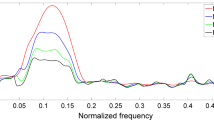Abstract
To suppress the strong noise in seismic data with wide range of amplitudes, commonly used methods often yield unsatisfactory denoising results owing to inappropriate thresholds and require parametric testing as well as iterations to achieve the anticipated results. To overcome these problems, a data-driven strong amplitude suppression method based on the decibel criterion in the wavelet domain (ISANA) is proposed. The method determines the denoising threshold based on the decibel criterion and statistically analyzes the amplitude index rather than the abnormally high amplitudes. The method distinguishes the frequency band distributions of the valid signals in the time–frequency domain based on the wavelet transformation and then calculates thresholds in selected time windows, eventually achieving frequency-divided noise attenuation for better denoising. Simulations based on theoretical and real-world data verify the adaptability and low dependence of the method on the size of the time window. The method suppresses noise without energy loss in the signals.
Similar content being viewed by others
References
Anderson, R. G., and Mcmechan, G. A., 1989, Automatic editing of noisy seismic data: Geophysical Prospecting, 37(8), 875–892.
Bekara, M., and Bann, M. V. D., 2009, Random and coherent noise attenuation by empirical mode decomposition: Geophysics, 74(5), V89–V98.
Cai, X. L., 1999, An effective method to suppress acoustic wave and high energy noise frequency-divisionally and adaptively: Oil Geophysical Prospecting, 34(4), 373–380.
Cai, X. L., and Lu, Y. M., 2005, Time-frequency analysis and frequency-divisional processing of seismic data: Progress in Exploration Geophysics, 28(4), 265–270.
Elboth, T., Geoteam, F., Qaisrani, H. H., et al., 2008, Denoising seismic data in the time-frequency domain: SEG Technical Program Expanded Abstracts, 9–14 November, Las Vegas, Nevada, USA, 2622–2626.
Gao, J. H., Wang, W. B., Zhu, G. M., et al., 1996, On the choice of wavelet functions for seismic data processing: Chinese Journal of Geophysics, 39(03), 392–400.
Gao, W., and Liu, H. S., 2013, Strong noise attenuation method based on the multiuser kurtosis criterion: Applied Geophysics, 10(1), 25–32.
Goswami, J. C., and Chan, A. K., 2011, Fundamentals of wavelets: theory, algorithms, and applications: John Wiley & Sons.
Linville, A. F., and Meek, R. A., 1995, A procedure for optimally removing localized coherent noise: Geophysics, 60(1), 191–203.
Niu, H., 2013, Application of frequency-dependent amplitude attenuation method to suppress strong-energy noise in offshore seismic data: Geophysical Prospecting for Petroleum, 52(4), 394–401.
Pan, J., Luan, X. W., Liu, H., et al., 2016, Application of anomalous amplitude noise attenuation in seismic data processingof multichannel survey: Progress in Geophysics, 31(4), 1639–1645.
Wang, D. X., Wang, Y. G., Zhao, Y. H., et al., 2016, A strong seismic reflection amplitude suppressing method applied in the Ordos Basin: SEG International Geophysical Conference, 20–22 April, Beijing, China, 389–391.
Wang, J., Zhou, X. Y., and Yun, C. H., 2011, Under the restriction of surface consistent anomaly amplitude decay technology implementation: Geophysical Prospecting for Petroleum, 50(5), 493–498.
Wang, S. Q., Meng, X. H., Yu, C. L., et al., 2006, Seismic abnormal amplitude self-adapting inhibition: Petroleum Geology & Oilfield Development in Daqing, 25(5), 112–115.
Yilmaz, Ö., 2001, Seismic data analysis: Processing, inversion, and interpretation of seismic data: Society of exploration geophysicists.
Zhang, J. H., 2011, The method of seismic data denosing: China University Of Petroleum Press House, China.
Acknowledgements
We wish to thank the Editor-in-Chief and the reviewers for their constructive comments and suggestions.
Author information
Authors and Affiliations
Corresponding author
Additional information
This work was supported by the National Science and Technology Major Project (No. 2011ZX05002-004-002), the National Natural Science Foundation of China (No. 41304111), Key Project of Science and Technology Department of Sichuan Province (No. 2016JY0200), Natural Science project of Education Department of Sichuan Province (Nos. 16ZB0101 and 14ZA0061), the Sichuan Provincial Youth Science & Technology Innovative Research Group Fund (No. 2016TD0023), and the Cultivating Program of Excellent Innovation Team of Chengdu University of Technology (No. KYTD201410).
Kong Xuan-Lin is studying for his PhD his PhD Degree in Applied Geophysics from Chengdu University of Technology. He is presently working in the Multiwave Seismic Technology Key Laboratory, SINOPEC as an associate researcher. His research interests are multicomponent seismic wave exploration, software development, and inversion methods.
Corresponding author: Chen Hui is an associate professor professor at Chengdu University of Technology. He received his PhD in Applied Geophysics from Chengdu University of Technology. He is presently working in the Geomathematics Key Laboratory of Sichuan Province. His research interests are seismic signal processing and analysis, oil and gas exploration methods, and reservoir prediction and hydrocarbon detection.
Rights and permissions
About this article
Cite this article
Kong, XL., Chen, H., Wang, JL. et al. An amplitude suppression method based on the decibel criterion. Appl. Geophys. 14, 387–398 (2017). https://doi.org/10.1007/s11770-017-0636-7
Received:
Revised:
Published:
Issue Date:
DOI: https://doi.org/10.1007/s11770-017-0636-7




